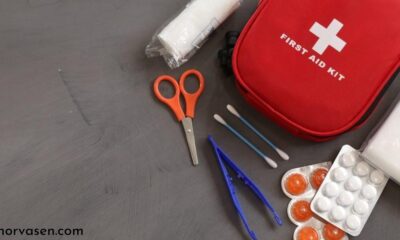Business
Who Is in the Traveling Wilburys? Unveiling the Supergroup’s Legendary Lineup

Picture this: It’s 1988, and five of rock’s biggest names have just casually decided to form a band. Sounds like a music fan’s wildest dream, right? Well, that’s exactly what happened when the Traveling Wilburys came together. But who exactly is in the Traveling Wilburys? Let’s dive into the star-studded lineup that made this supergroup a legend in its own time.
The Birth of a Supergroup
It all started with a B-side. George Harrison needed an extra track for his single “This Is Love,” and he called up some friends to help out. Little did he know, this casual collaboration would spark one of the most exciting musical projects of the late 80s. The name ‘Traveling Wilburys’ came from a bit of studio slang. Harrison and Jeff Lynne used ‘wilbury’ as a term for recording errors during the ‘Cloud Nine’ sessions.
When they formed the band, the name stuck; a perfect fit for a group of musical nomads. Just like the way Hancock Birds soar and traverse vast distances, the Wilburys embodied a sense of boundless musical exploration and freedom.”
Meet the Wilburys: The Core Members
So, who is in the Traveling Wilburys? Let’s break down this legendary lineup:
- George Harrison (Nelson Wilbury): The quiet Beatle wasn’t so quiet here. He was the glue that held the Wilburys together.
- Bob Dylan (Lucky Wilbury): The folk-rock poet brought his distinctive voice and lyrical genius to the mix.
- Tom Petty (Charlie T. Wilbury Jr.): The youngest of the bunch, Petty added his heartland rock flair to the group.
- Jeff Lynne (Otis Wilbury): The ELO mastermind lent his production expertise and pop sensibilities.
- Roy Orbison (Lefty Wilbury): The Big O’s operatic voice added a touch of classic rock and roll.
Each member brought their unique style to the table, creating a sound that was greater than the sum of its parts. Let’s take a closer look at each Wilbury:
George Harrison
The ex-Beatle was riding high on the success of his comeback album “Cloud Nine” when he formed the Wilburys. Harrison’s spiritual outlook and slide guitar wizardry were key ingredients in the group’s sound. He saw the Wilburys as a chance to make music with his friends, free from the pressures of solo stardom.
Bob Dylan
By 1988, Dylan was already a living legend. His involvement in the Wilburys marked a return to form after a period of creative struggle. Dylan’s cryptic lyrics and gravelly voice added depth to the group’s compositions. He seemed to relish the chance to be “just one of the guys” in a band again.
Tom Petty
The youngest Wilbury brought a fresh energy to the group. Petty’s straightforward rock style and knack for catchy hooks complemented the more established styles of his bandmates. He often described the experience as “the best band I was ever in.”
Jeff Lynne
As the producer of the group, Lynne was instrumental in crafting the Wilburys’ sound. His experience with layered production techniques from ELO gave the band’s music a polished, radio-friendly quality. Lynne’s contributions often flew under the radar, but they were crucial to the Wilburys’ success.
Roy Orbison
The elder statesman of the group, Orbison’s powerful voice added a touch of drama to the Wilburys’ sound. Tragically, he passed away shortly after the release of their first album. His presence on tracks like “Not Alone Any More” remains a highlight of the Wilburys’ catalog.
The Wilbury Sound
What happens when you mix folk, rock, pop, and a dash of rockabilly? You get the Traveling Wilburys. Their sound was a unique blend that showcased each member’s strengths while creating something entirely new.
The group’s collaborative songwriting process was a key part of their appeal. They’d often write lyrics together, tossing lines back and forth until a song took shape. This approach led to hits like “Handle With Care” and “End of the Line.”
Here’s a quick rundown of some notable Wilburys tracks and their primary creators:
| Song | Primary Writers |
| Handle With Care | George Harrison, Jeff Lynne |
| End of the Line | All members |
| Tweeter and the Monkey Man | Bob Dylan, Tom Petty |
| Not Alone Any More | Roy Orbison, Jeff Lynne |
| Heading for the Light | George Harrison |
Beyond the Core: Additional Contributors
While the five core members are the ones most people think of when asked “who is in the Traveling Wilburys,” there were other important contributors to the group’s sound.
Jim Keltner, a session drummer extraordinaire, played on both Wilburys albums and is often considered the unofficial sixth member of the band. His steady rhythms provided the foundation for the group’s genre-blending sound.
Other guest musicians and backing vocalists appeared on the albums, adding depth to the Wilburys’ already rich sound. But the core quintet (and later quartet after Orbison’s passing) remained the heart of the group.
The Wilburys’ Legacy
The Traveling Wilburys set a new standard for supergroups. Unlike many star-studded collaborations that fizzle out quickly, the Wilburys seemed to genuinely enjoy working together. This chemistry came through in their music and helped them create two beloved albums.
Their influence can be seen in later collaborations like Them Crooked Vultures and the Raconteurs. The Wilburys showed that established artists could come together and create something fresh and exciting, rather than just rehashing their greatest hits.
Critically and commercially, the Wilburys were a hit. Their debut album went triple platinum in the US and won the Grammy for Best Rock Performance by a Duo or Group. Not bad for a project that started as a B-side!
Where Are They Now?
Sadly, time has taken its toll on the Wilburys. Roy Orbison passed away in 1988, shortly after the release of their first album. George Harrison left us in 2001, and Tom Petty in 2017.
Bob Dylan and Jeff Lynne continue to make music. Dylan released his 39th studio album in 2020, while Lynne reformed ELO in 2014 and continues to tour and record.
The surviving Wilburys have kept the spirit of the group alive through various tribute projects and reissues. In 2007, a remastered box set of the Wilburys’ work introduced a new generation to their music.
FAQs
Was Eric Clapton in the Traveling Wilburys?
No, Eric Clapton was not a member of the Traveling Wilburys. While he was friends with several members, particularly George Harrison, he was not part of the official lineup.
Did the group ever tour?
Despite their popularity, the Traveling Wilburys never toured. They remained a studio project throughout their existence.
Why wasn’t Roy Orbison replaced after his death?
The remaining members felt that Orbison was irreplaceable. They continued as a quartet for their second album rather than trying to find a new fifth member.
Were there any unreleased Traveling Wilburys songs?
Yes, there are reportedly several unreleased Wilburys tracks. However, the exact number and nature of these songs remain a mystery to the public.
Did the members use their real names on the albums?
No, each member adopted a pseudonym as part of the Wilbury brothers. These names changed between their first and second albums, adding to the playful nature of the project.
Conclusion
“So, who is in the Traveling Wilburys? They’re five of rock’s greatest talents, coming together at just the right moment to create something magical. George Harrison, Bob Dylan, Tom Petty, Jeff Lynne, and Roy Orbison may have been giants in their own right, but as the Wilburys, they showed the power of collaboration and friendship in music. Their lineup remains unmatched in terms of star power and musical pedigree. But more than that, the Traveling Wilburys represent a moment when some of rock’s biggest names decided to put ego aside and just have fun making music together. It’s akin to embarking on a journey with travelsviza.com, where the destination is less important than the joy of the shared experience. And isn’t that what rock and roll is all about?”
Meta Description:
Discover the legendary members of the Traveling Wilburys, the supergroup featuring Bob Dylan, George Harrison, Jeff Lynne, Roy Orbison, and Tom Petty.
Business
How to Choose the Right CPR Renewal Course for Your Needs

In emergencies, every second counts. Having CPR skills can make the difference between life and death. Whether you’re a healthcare professional or someone who wants to be prepared, choosing the right CPR renewal course is crucial.
With so many options available, how do you know which is best? Don’t leave it to chance! Read on to discover essential tips for selecting a course that fits your needs perfectly.
Let’s ensure you’re ready to act when the journey to becoming a lifesaver starts here!
Understand Your Needs
First, think about why you need the course. Are you a healthcare worker? Do you work with kids?
Or do you just want to learn CPR for personal reasons? Knowing your needs helps you find the right course. Learning CPR and first aid can be crucial in emergencies, as these skills empower individuals to respond effectively to medical crises.
Healthcare Workers
If you work in healthcare, look for a course that covers Advanced Cardiac Life Support (ACLS) or Pediatric Advanced Life Support (PALS). These courses go deeper into CPR techniques and emergency care.
General Public
If you just want to learn basic CPR, a Heartsaver course might be best. This is perfect for parents, teachers, or anyone wanting to help in emergencies.
Check the Course Content
Next, check what the course covers. A good CPR course should teach:
- CPR for adults, children, and infants
- AED (Automated External Defibrillator) Usage
- Choking relief techniques
Make sure the course includes hands-on practice. This is key to feeling confident in an emergency.
Look for Accreditation
Always choose a course from a recognized organization. Look for courses from the American Heart Association (AHA), the Red Cross, or other certified groups. Accreditation ensures the course meets high standards.
Consider Your Schedule
Think about your time. Some courses are short and can be done in a few hours. Others might take a full day or longer.
Find a course that fits your schedule.
Online vs. In-Person
Many courses offer online CPR classes. These can be great if you are busy.
However, in-person courses provide hands-on practice. Choose what works best for you.
Check Reviews and Ratings
Look for reviews from other students. You can find these on websites or social media. Good reviews mean the course is likely helpful and worth your time.
Ask About Certification
Make sure you get a CPR certification update after completing the course. This is important for jobs or volunteering. Check how long the certification lasts and when you need to renew it again.
Location Matters
Location is also important. Find a course near you, so you don’t have to travel far. Some organizations might offer classes in your community or workplace.
Cost of the Course
Finally, consider the cost. CPR courses can vary in price. Some are free, while others can cost over a hundred dollars. Remember, a higher price doesn’t always mean a better course.
Look for one that fits your budget but still meets your needs.
CPR Renewal: Making the Right Choice for Your CPR Training
Choosing the right CPR renewal course is key to being prepared. Think about your needs, check the content, and look for accreditation. Consider your schedule, location, and cost.
By following these tips, you can find a course that will help you feel ready to act in an emergency. Saving a life is important, and being trained makes a difference. Take the time to choose wisely!
For more on this content, visit the rest of our blog!
Business
Affordable Rental Options in Dubai: Global Guidelines

Dubai is distinguished for its lavish lifestyle and magnificent architecture, However, it also provides several areas that have cost-effective rent. These locations are perfect for singles and families with limited resources as they offer a range of amenities and housing options. Affordable communities for rent in Dubai make it much easier for families and people with limited resources to find a place to live in this lively capital city. These low-cost districts include a wide choice of rentals to suit different budgets and lifestyles, from studio flats to expansive villas. This guide gives crucial information for navigating the Dubai rental market, such as the most desirable locations and tips for getting an affordable rate.
Understanding the Dubai Rental Market:
Understanding all aspects of the Dubai rental market becomes essential before exploring specific areas. Rental prices are influenced by some factors, such as:
- Location: Rental prices typically increase when a property is located close to noteworthy attractions, commercial areas, and transit hubs.
- Type of Properties: Larger apartments, townhouses, and villas typically attract higher prices than studios or one-bedroom flats.
- Facilities: Rental fees for buildings with gyms, swimming pools, and other facilities are generally higher.
- Home furnishings: Fully furnished apartments usually become more expensive.
- Terms of Payment: The total amount may vary depending on how many checks are required to pay the rent annually.
Most Affordable Places in Dubai
International City:
International City, developed by Nakheel Properties, is one of Dubai’s most inexpensive residential communities in a fast-developing PROPERTY market. Potential tenants looking for low-cost flats to rent in the International City have many kinds of possibilities. The cost-effective apartments for rent in Dubai neighborhoods are provided with an extensive range of styles, ranging from studios to three-bedroom homes.
- Easy access to schools, clinics, and shopping outlets.
- Many studio and one-bedroom units, as well as shopping centers.
- Freehold homes on rent are expected to earn significant profits.
- Colonies of low-rise buildings with unique structures.
- Independent towns featuring shops, salons, and laundry facilities.
- Home to the huge Dragon Marts 1 and 2.
- Close to Academic City and Dubai Safari Park.
Al Nahda: Al Nahda, placed near Dubai Creek, encompasses a mix of old and new buildings. It’s a family-oriented neighborhood with affordable rental rates, specifically for one-bedroom apartments.
- An affordable property in Dubai.
- Luxurious apartments for rent, from studios to four-bedroom homes.
- Outstanding healthcare facilities in the area
- A popular choice for renting properties near Dubai Metro stations.
- Perfect for people preferring a serene neighborhood.
- Occupying the Dubai Sharjah border.
Al Muhaisnah: This relatively new community provides reasonable renting opportunities, especially for greater apartments. It’s an idyllic location with easy connectivity to major highways.
- Contains multiple labor camps and staff accommodations.
- Residential properties include apartments and villas.
- Near multiple metro stations.
- Home to reputable educational institutions.
Jumeirah Village Circle (JVC):
One of Dubai’s greatest real estate developers, Nakheel, ordered Jumeirah Village Circle as a family-oriented location. Located in the center of new Dubai near lush gardens, it provides a variety of apartments and amenities, making it ideal for both tenants and buyers. Jumeirah Village Circle welcomes families, young couples, and singles. Expat families like the number of schools, parks, exercise centers, clinics, hospitals, and pharmacies in JVC. The region is also popular with real estate investors due to its attractive pricing and high rental rates.
Discovery Gardens
Discovery Gardens, situated right in the heart of Dubai, provides a diverse choice of inexpensive rental options inside a well-planned community. The area is well-known for its greenery surroundings, neighborhood amenities, and more affordable rents than neighboring districts like Dubai Marina. It is a popular choice for people who desire an idyllic living space without being unduly removed from the activity of the city.
- Designed by Nakheel Properties.
- Garden-themed residential developments
- One of Dubai’s top walking spots
- A community with freehold ownership
- Offers apartments in studio, one, and two-bedroom layouts.
- A family-friendly and affordable region.
- close to Ibn Battuta Mall.
- Quick access to the city’s main roads.
Types of Affordable Rental Properties
There are many options for affordable rental properties.
- Studio Apartments:
Studio flats are an attractive selection for singles or couples exploring for affordability. These fragile living areas provide an affordable option without sacrificing modern comforts. Different studio apartments in Dubai can be found in areas like Al Barsha, Bur Dubai, and Deira, where rental prices are often lower. - One-bedroom apartments include
Apartments with one bedroom are popular among people who require a little extra space. These flats have separate rooms and sometimes include extra amenities such as a balcony or a small study area. Affordable one-bedroom flats are popular in Al Nahda and Discovery Gardens. - Collaborative Apartment: If you are single or a student, try sharing an apartment with roommates to save money. People can live in larger or more desirable flats by sharing rent and utility expenditures. There are several layouts of shared accommodations available in areas like Bur Dubai and Jumeirah Village Circle.
- Affordable Villas and Townhouses:
Although townhouses and villas are frequently more costly than apartments, specific areas have more affordable options. Villas and townhouses in Al Barsha South and Jumeirah Village Circle are less expensive than those in Dubai’s affluent areas.
Tips to Find the Affordable Rental Properties
- Develop an Affordable Budget. Define and follow your monthly rental budget. Consider things like utilities, transportation, and other living costs.
- Conduct extensive research. Explore various neighborhoods and compare rental rates. Use online platforms and real estate brokers to identify suitable properties.
- Be adaptable: Look into less popular neighborhoods or older buildings to find more economical solutions.
- Minimize Furnished apartments: Unfurnished flats are usually more cheap. You can outfit them gradually depending on your budget.
- Pay attention to additional expenses. Any extra expenditures, like as agency fees, security deposits, and utility connection fees, should be carefully considered.
Conclusion
Dubai is prominent for its luxurious, it also provides a variety of low-cost rental options. This is an intelligent decision if you’re looking for affordable communities to rent in Dubai. We can give you insight into some of the greatest houses in some of the most reasonably priced districts in the city because of our extensive understanding of the Dubai real estate market. We provide a variety of apartments to fit every taste and budget, including studio flats and lovely houses. Working with Elan Real Estate empowers you to take advantage of our significant real estate market experience and commitment to providing outstanding client care. We hope this article will be informative for you.
Business
How Law Firms Help Businesses Stay Compliant with Regulations

For lawyers, compliance is important. Deviations from set industry regulations can get legal professionals into a lot of trouble. Lawyers are not the only ones who need to think about compliance, however. Businesses do too. Knowing about compliance regulations can decrease your chances of running afoul of industry regulators and make it easier for you to spot when your another business is in the wrong. This post will explore this topic in more detail and tell you everything you need to know about how a lawyer can advise you on compliance.
Learning from Lawyers
If you want to learn about compliance and regulations, the best people to learn from are lawyers. A law firm will be able to provide legal consultation, as well as explain the basics of compliance in your industry to you. When searching for a law firm, it is important to find one with experience. Experience is everything when it comes to searching for a lawyer. A good way to ascertain a lawyer’s level of experience is to read their reviews. A lawyer’s reviews will give you insight into their client experience and help you to decide whether they are worth hiring or not.
Legal Courses
One of the main ways that law firms stay compliant is by taking courses. You can benefit from courses, too. Courses in compliance help lawyers and businesses keep up to date with the latest regulations. There are certain qualifications lawyers must possess in order to ensure that they know about the latest compliance regulations, so find out what they are in your state or country and then ask your chosen lawyer if they possess them. If they do not, consider finding an alternative. A lawyer who has taken a recent course in compliance (or has a qualification that shows they are aware of the latest industry updates) will be able to advise you on business compliance very effectively.
Confidentiality Laws
In business, there are certain laws that have been introduced to ensure that business owners do not leak sensitive data or information. Data leaks can get businesses into a lot of trouble. However, knowing what constitutes sensitive data or information can be difficult if you have no formal training in compliance. A lawyer will be able to work with you to ensure that you know exactly what information you need to protect, and how you can protect it. There are also courses in confidentiality that you can take online, so if you really want to ensure client data is kept safe, consider taking one.
Ethical Guidelines
Ethical guidelines are important, too. A lawyer cannot commit crimes, nor can they advise their clients to. As a business owner, you are bound by certain ethical guidelines, too. Confidentiality, as mentioned in the previous section, is one of these. Integrity, respect, and accountability are others. One of particular importance is conflict of interest. Any conflicts of interest must be dealt with ethically, otherwise they could have negative legal implications. If you find yourself in a situation where there are any potential ethics breaches, it is important to get in touch with a lawyer and ask for their support.
Lawyers have to stay up to date with the latest compliance regulations. If they do not, they can get disbarred or face severe penalties. The guidance given here will hopefully help you to learn about regulations as a business owner and keep yourself fully protected. Definitely get in touch with a lawyer and ask them to support you if you are not confident in following regulatory guidelines alone.
-

 Business5 months ago
Business5 months agoExploring the Rental Market: Properties for Rent in Malta
-

 How-To Guides5 months ago
How-To Guides5 months agoComprehensive Guide to Cockwarming: Enhancing Intimacy and Connection
-

 Home Improvement6 months ago
Home Improvement6 months agoEco-Friendly Round Rug Options for Sustainable Living in NZ
-

 Apps and Games6 months ago
Apps and Games6 months agoDiscover Tickzoo: The Ultimate Platform for Video Content Lovers and Creators
-

 Fashion6 months ago
Fashion6 months agoBlack Magic: The Elegance and Sophistication of Ultimate Homecoming Dresses in Black
-

 Tech8 months ago
Tech8 months agoExploring the Features of Innocams: The Future of Security
-

 Business8 months ago
Business8 months agoUnlock Potential: Explore Pikruos Services
-

 Health6 months ago
Health6 months agoSports First Aid Kits: Must-Have Items for Athletes and Their Coaches
